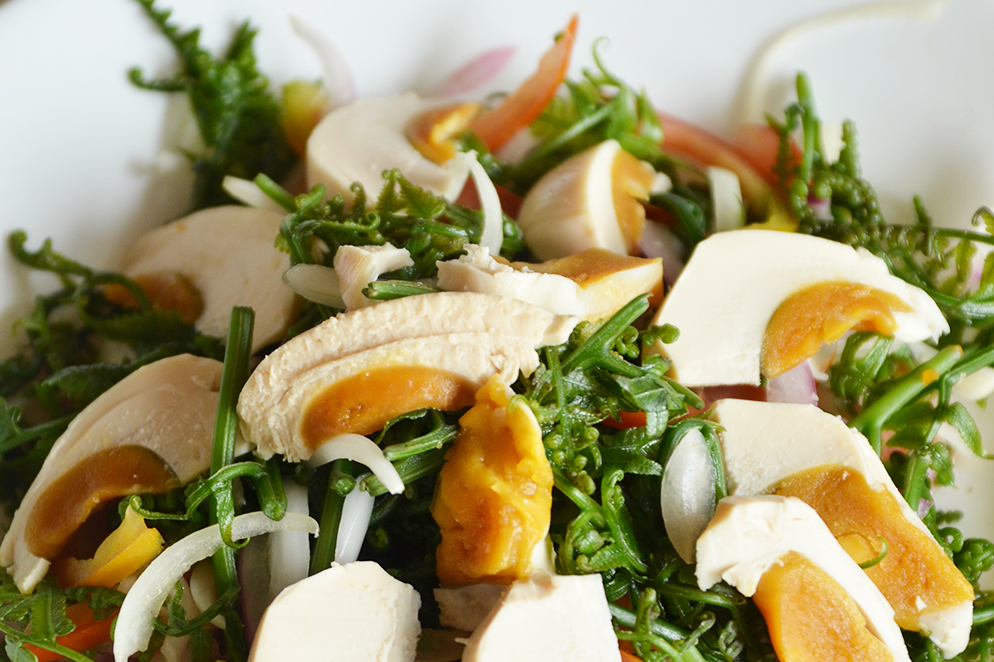“ Cooking is not an end in itself. It is a process. It is in this process where art emerges. I was 11 years old when I first had the courage to cook our own meal since my Mom started to become sick during that time. It was really a challenge. But when the torta was made, I never failed to satisfy my Ima (mother) as she said that I just cooked one of the most delicious meals in the world,” recalled Elsa Bautista, a professional cook and owns a restaurant called Binalut in San Fernando, Pampanga.
When I arrived at Elsa’s place, the whole smell of the atmosphere will take you back to an old woman’s kitchen where garlic and onions were sautéed very well and the smell of their mixture is like opium that seethes through your gastronomic senses. “ I was the type of a young girl who would rather sneak through the kitchen and watch my apu (grandmother) slice the onions and pound the garlic. It was almost an immortal sin or a “taboo” if you reverse the method of processing these spices since garlic is best when juice extracts are produced through pounding, “ she continued.

“ The best cook is the one who go to the market and buy the ingredients for his/her dishes. If a cook knows what is the freshest meat for the dish or the best type of vegetables that suits a certain feast, he or she can surely cook well. Because a good Kapampangan cook will never simply accept what available ingredients are present in the kitchen. He or she is the one that chooses these ingredients and make them available. “
It was the same day as the typhoon Yolanda hit the Philippines when I arrived at Ms. Elsa’s place in Sindalan. While the horrible typhoon was affecting the entire Visayas region, I roamed around the province to get potential news updates and at the same time, I had in mind to take my lunch break by interviewing Ms. Elsa in her own restaurant which was the Binalut. She was introduced to me by a good friend of mine, Rey Maniago during the time when I was looking for traditional Kapampangan cooks that still carry the old ways of cooking. And I never failed. Ms. Elsa was really a one hell of a cook!
“ The best cook is the one who goes to the market and buys the ingredients for his/her dishes. If a cook knows what is the freshest meat for the dish or the best type of vegetables that suits a certain feast, he or she can surely cook well. Because a good Kapampangan cook will never simply accept what available ingredients are present in the kitchen. He or she is the one that chooses these ingredients and makes them available. “ emphasized Ms. Elsa.
Ms. Elsa’s roots, the Trinidads, were from Santa Rita, Pampanga. Coming from the lineage that was known to be a rich family during the colonial period, their old ancestral house was located just in front of the Santa Rita De Cascia Church. Ms. Elsa’s passion for cooking was rooted starting from her apu down to her mom. “ My apu would then show me her ways how to cook and while cooking, discussed how my great-great-grandmother would be so meticulous in getting the perfect taste of let’s say, Kari Kari-not leaving the kitchen unless satisfied for the final output of the dish, “ she recollected.
Elsa remembered that during her stay in Pangasinan where they had a house just almost three kilometers from the Hundred Islands, her mom would wait for the fishermen ashore to collect the fresh “alamang” early in the morning just to prepare the “baguk”. Her mom’s baguk, which she calls “Baguk nang Apu Ku” as part of the side dishes offered at her restaurant, was relatively the best-tasting baguk the Kapampangan restaurant can offer since the freshness of the baguk coming directly from the sea and treated with the salt locally bought in Pangasinan can be served in raw.

“Being a good cook means you love your ancestors so much that you respect their method in doing what they had, which became an heirloom, and living to tell the tale to the new generations. It is one way of paying respect to the elders, on how they did it before.”
‘I remember when I really wanted to learn how Aling Lucing cooks the sisig. I was in my late teens when I would go to crossings in Angeles and stayed there, making friends with the staff and crew and pretended to wash my hands in the kitchen just to sneak through what’s going on with their process of cooking. With that, I realized that the real technique in having a good-tasting sisig lies not in the meat of the pork. But in the mixture of seasonings when it is being boiled with water to tenderize the meat for grilling,” said Ms. Elsa.
During the interview, I was served with a combo of Ms. Elsa’s Binalut meal, which made my stomach revolt in urgency to eat as the saliva in my mouth was drizzly. The serving of the tagilo made me eat almost entirely the steamed vegetables and the dessert, which she calls “inangkit” (fried suman and santan sauce with langka). The buko juice gave a soothing feeling of relief.

One of the old Kapampangan recipes Elsa shared with me was the postri (sauted banana). Her method of preparing starts in buying the native garlic and pounding them moderately until the juice extracts come out. The ratio is two cloves of garlic on 5 pieces of banana (saging saba is preferred) while frying them and pouring a teaspoon of mixtures of brown and white sugar.
“For me, being Kapampangan is not just being at the culinary capital of the Philippines. My passion for cooking was not just about impressing non-Kapampangans how good we are in making the best tasting food. Being a good cook means you love your ancestors so much that you respect their method in doing what they had, which became an heirloom, and living to tell the tale to the new generations. It is one way of paying respect to the elders, on how they did it before. You see, to become a good Kapampangan cook not merely lies in the skills. It is but a way of life,” Elsa shared.
1st publication: November 12, 2013
Headline Gitnang Luzon





